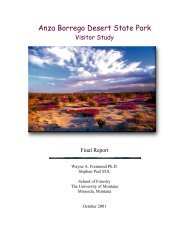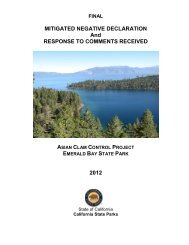Prairie Creek Redwoods State Park Brochure - California State ...
Prairie Creek Redwoods State Park Brochure - California State ...
Prairie Creek Redwoods State Park Brochure - California State ...
You also want an ePaper? Increase the reach of your titles
YUMPU automatically turns print PDFs into web optimized ePapers that Google loves.
A<br />
long <strong>California</strong>’s<br />
rocky north coast,<br />
<strong>Prairie</strong> <strong>Creek</strong><br />
<strong>Redwoods</strong> <strong>State</strong><br />
<strong>Park</strong> offers sandy<br />
beaches and open<br />
meadows grazed by<br />
herds of Roosevelt<br />
elk. Ferns appear<br />
to flow like a green waterfall down steep<br />
canyon walls, and old-growth redwoods<br />
stand in primeval majesty.<br />
Summer brings morning fog, which usually<br />
burns off by midday. Winter rains bring<br />
needed water to the redwoods and ferns.<br />
PARK HISTORY<br />
Native <strong>California</strong> Indians<br />
Yurok people have lived in and around<br />
today’s <strong>Prairie</strong> <strong>Creek</strong> <strong>Redwoods</strong> <strong>State</strong> <strong>Park</strong><br />
for generations. The temperate climate<br />
and abundant wildlife of the north coast<br />
promoted a culturally rich way of life that<br />
continues today. Yurok people built villages<br />
of redwood planks along major waterways.<br />
Traveling by dugout canoe, they fished for<br />
salmon. They also hunted elk, deer and<br />
other small game and gathered plants.<br />
In 1850, when gold was found near<br />
today’s Fern Canyon, the Yurok people<br />
were overwhelmed by an influx of settlers.<br />
Conflict over the land took many forms.<br />
The native people were hunted down; any<br />
who survived the attacks were forced onto<br />
reservations. Newly introduced diseases<br />
further decimated their numbers.<br />
Today, the Yurok have made a remarkable<br />
recovery. As the most populous tribe<br />
in <strong>California</strong>, nearly 5,500 Yurok live in<br />
Humboldt and Del Norte counties. Tribal<br />
members are building a future by revitalizing<br />
their ancestral language and traditions based<br />
on customs of the past.<br />
Settling the North Coast<br />
The first marine explorers along the<br />
Humboldt-Del Norte coast were Spaniard<br />
Bartolome Ferrelo in 1543, Englishman<br />
Sir Francis Drake in 1579, and Spaniard<br />
Sebastian Vizcaíno in 1602. The first shore<br />
landing, near Trinidad Head, was made by<br />
Bruno Hezeta and Juan Bodega in 1775.<br />
In May 1850, miners crossing today’s Gold<br />
Bluffs Beach saw bits of gold in the sand.<br />
Removing the gold proved too laborious, so<br />
the prospectors moved on.<br />
Yurok plank houses near Trinidad<br />
Illustration by J. Goldsborough Bruff<br />
ca. 1851<br />
However, settlers needed raw materials<br />
to build their homes and towns. By the<br />
1890s, several short-line railroads and<br />
steam donkeys had helped create a boom<br />
in commercial logging. Lumber quickly<br />
became the west’s top industry—Eureka<br />
alone had nine sawmills.<br />
By the end of the 19th century, farms,<br />
ranches and dairies had been developed<br />
along the north coast. Today, several of<br />
these historical dairies remain a vital part<br />
of the north coast’s economy.<br />
Conservation and <strong>State</strong> <strong>Park</strong>s<br />
Between 1880 and the early 1900s,<br />
thousands of acres of old-growth redwoods<br />
had disappeared; in many areas, the trees<br />
had been cut to the bare ground.<br />
Alarmed, conservationists established<br />
the Save the <strong>Redwoods</strong> League in 1918

















